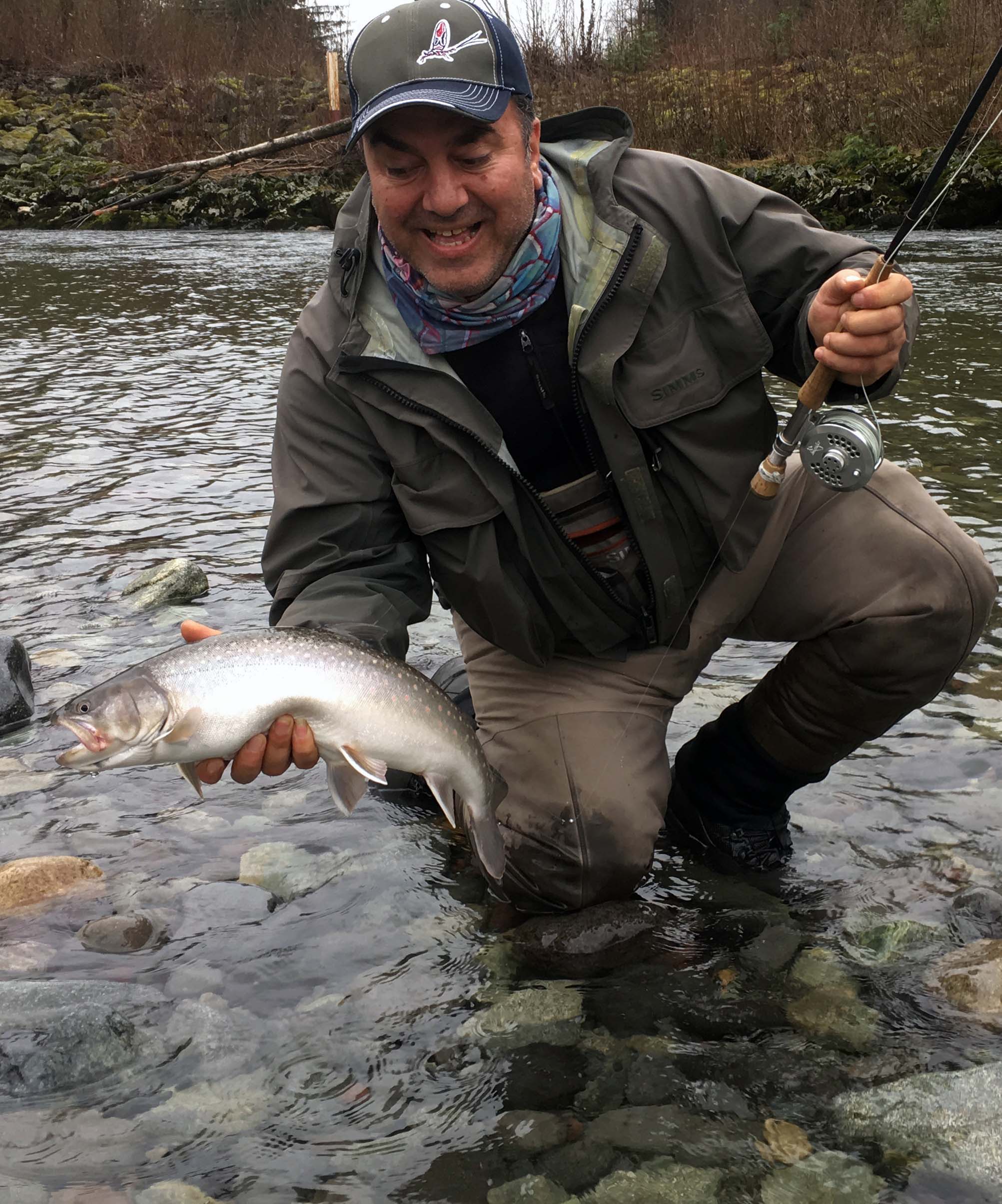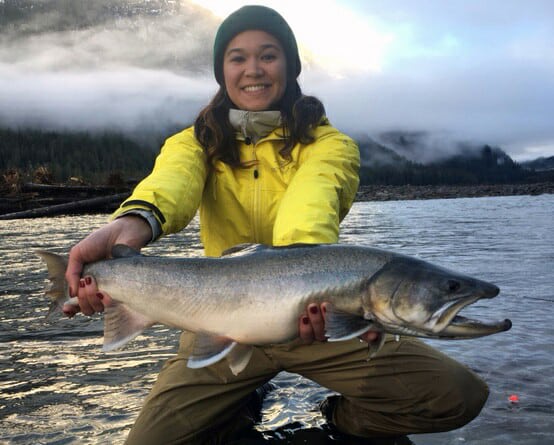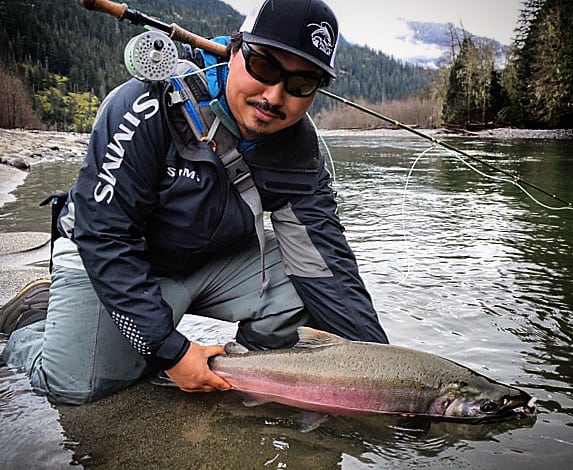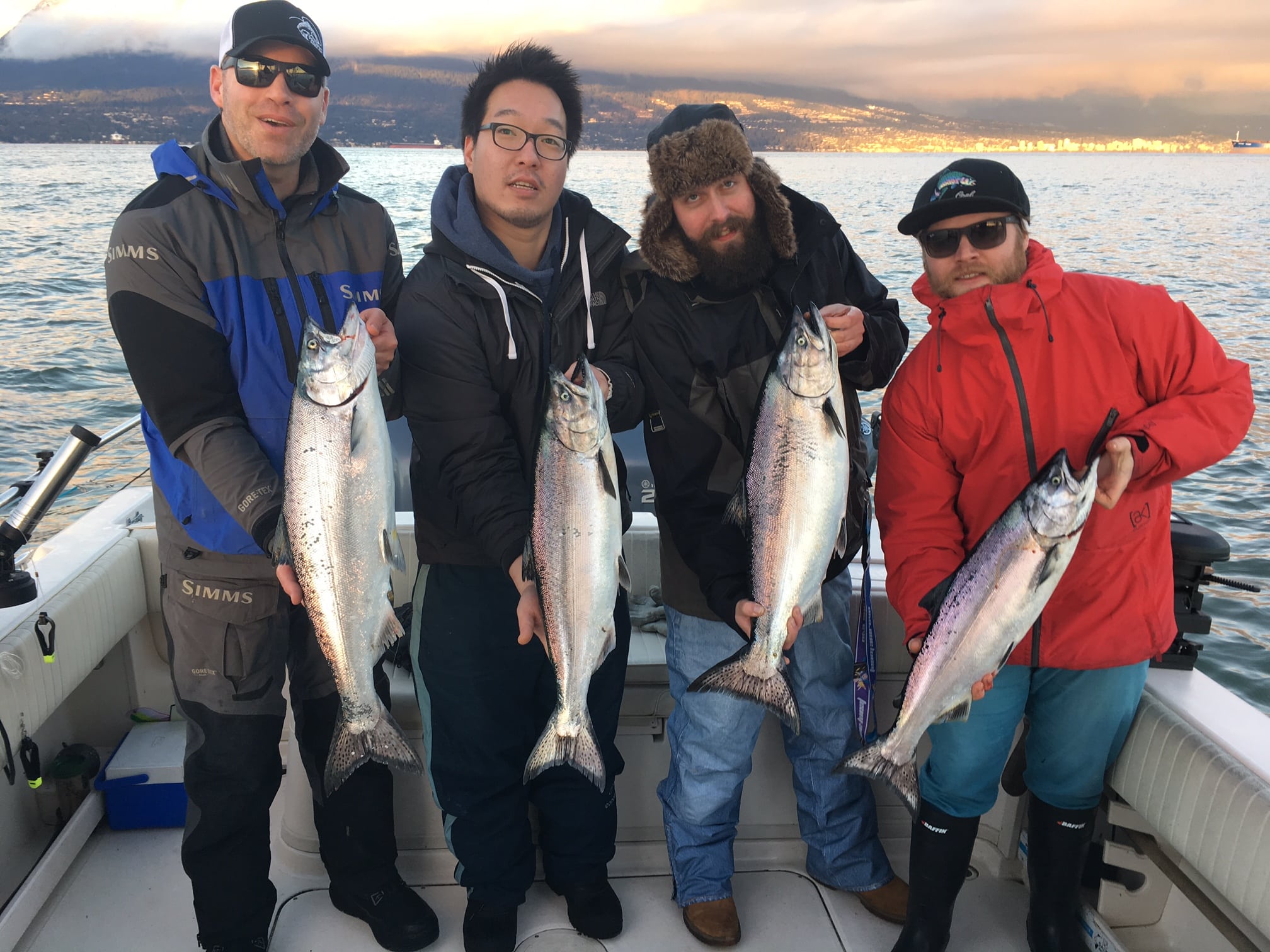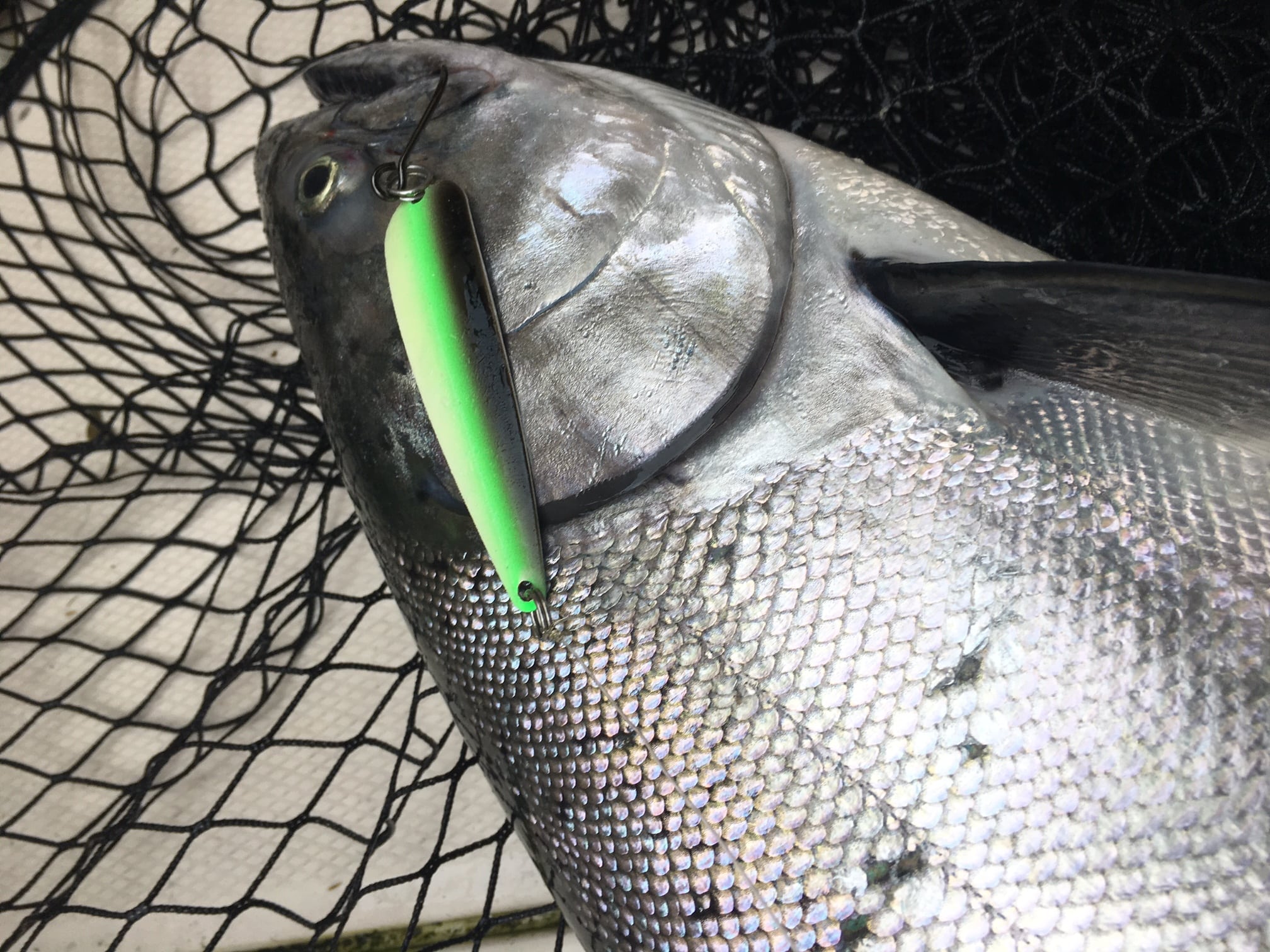OUTLOOK
Things are getting cold! It may be a little late for river salmon season but the mix of rain and cold weather is great for egg fishing for bull trout. We have had a number of great reports this week and though we have been on a constant weather watch for blown out rivers, anglers have been finding fish.
The salmon fishing in the Vedder is almost completely over. We had some good bull trout reports and we are eagerly awaiting reports of steelhead, which should be coming soon. Check out Alex’s Vedder report for more details.
When the weather has cooperated, winter spring fishing has been great. Don’t miss Jay’s write up at the end of the report. He had an excellent day earlier this week.
The Squamish, though still facing water issues, is fishing well for bull trout. We have re visited Matt’s write up on the Advanced Beading Rig for bull trout. Andre had a good day earlier this week fishing beads. It was the first time in over 20 years he fished eggs and it was interesting to see what he thought of the “new” beading rigs. We expect more good reports this weekend.
This week we are featuring another great fly fishing reel as our Friday Feature Product so be sure to get all of the details on that in this week’s report.
CLASSES AND COURSES
Our 2016 classes have wrapped up for the year. Keep an eye out for our 2017 Course listing to be announced soon! Thanks to all of our students for a wonderful year of support for our classes and instructors.
FRIDAY’S FEATURE PRODUCT
One week Sale – Sage 2280 Fly Reel Reg $195.00 15% OFF Now $165.00
The Sage 2280 Fly Reel is one of the best cost effective large arbour 8wt reels on the market, the Sage 2280. We have it on sale at 15% off in the 8wt size. The 2280 has the same drag as many of the higher end Sage reels but with a pressure cast frame, Sage has kept the price down. It is a great starter steelhead reel and a great real for all coastal salmon. Though we would not call it a saltwater workhorse, it could also be used in saltwater environments if well maintained and treated with respect.
2280 Features: A large arbor with rugged machined die-cast frame, generous concave spool surface, whisper-smooth carbon drag and unexpected finishing touches like its fully machined drag knob and handle, the 2200 gives you more than the fish bargained for.
Come down to the shop if you are looking for an 8wt reel and check them out!
(Sale in effect Friday December 2, 2016 through Thursday December 8, 2016)
SPECIAL FEATURE
AFTER 20 YEARS Andre Is Back to Egging!
It has been twenty years since the last time I went egging for trout. The reason being is that when I went egging in the Allouette River for cutthroat, the fish swallowed the egg pattern so deep that it went belly up as I released it. As cutthroat are my favorite fish I was devastated. Then there were only the egg patterns, which were tied with wool unlike the beads that have become popular locally in the last 6-8 years (mostly because of Matt). This style was first developed in Alaska and the bead is rigged above the hook so that most fish are hooked in the side of the mouth. After a few years of watching others have amazing success with zero mortality I decided to end my twenty-year break and head to the Cheakamus River in search of trout.
The water was flowing nice at 1.0 meters and finally it was clear for once in the last month and a half. I didn’t see any eggs close to shore or flowing downstream so I picked a trout bead out of the three colors I had since I left my old school egg patterns at home on purpose and started fishing. After adjusting my indicator for the depth I still wasn’t sure if I had the right color egg on since I wasn’t getting any fish fishing behind the spawning salmon. It is then that I came up with the A.S D.E.R setup (Double egg rig)
I thought why not offer them two different colored eggs as I am not sure which one they are eating and see if it will work. First cast with this setup and BANG!! The indicator disappeared. As I landed the fish and I was reassured that the egg wasn’t deep in the throat I was filled with joy and continued fishing this way.
We caught a few more in different spots of the river. After a day like this you can be sure that I wont be taking another break for twenty years and will be back soon for more. See my pick of the double rig for something to try and check out Matt’s advanced indicator Nymphing rig below. He gets very technical with this fishery but it works.
See you on the river!
Andre
Pacific Angler’s Advanced Indicator Nymphing Rig
This is still one of the best ways to dead drift a nymph style fly. It is specifically designed for nymphing eggs in the winter and helps combat a number of factors that challenge anglers hoping to achieve the perfect dead drift presentation.
To understand the “Advanced Nymphing Rig” we have to look at the presentation of the dead drift and identify the challenges that occur when we attach a fly line and leader to the fly. The first of these challenges is line drag. Modern monofilament tapered leaders have short front tapers. Their taper is designed to cast the fly well and does not take into consideration how the fly will drift under the water after the cast. When nymphing we are very rarely casting a long way where a short front taper will help deliver of the fly. When the long thick back portion of the standard leader hits the water, the thick part of the leader causes drag. Drag is the bane of any nymph fisherman and even uneducated, hungry fish can reject a fly that is dragging in an unnatural way.
The second challenge that affects a standard leader is its sink rate. The same way the thick tapered lead will drag in current it also drags as it sinks and the fly will not sink quickly or naturally. This slow unnatural sink shortens the amount of time your fly is in the zone.
The Solution – The Advanced Nymphing Rig
When building a custom leader we can use the concepts above and design a better leader. The first part of the recipe is a very thick 20-30lb butt section. On this butt section I place my Indicator. For most applications, I use Fish Pimp indicators or Thing-A-Ma-Bobber. On the Skagit/Birkenhead (smaller shallow streams) I use 3 ft of butt material. Oddly enough on bigger deeper rivers I use less because I do not need to change the placement of my indicator as much.
I have been playing with using different colored mono in this butt section as well as Rio indicator tippet. With many of my mends I like to hop the indicator off the water and with brightly colored line like Pro-spec yellow, I can see the angle at which the line is heading below the indicator. This angle can tell me a lot about how natural my drift is. In an ideal world the line goes almost straight down from the indicator. If I see it at a big angle I know my fly is dragging or not sinking and I need to mend to fix it.
From the butt section I use 1ft section of 10-15lb fluorocarbon or Rio Indicator Tippet. This gives the leader a little taper. I find it helps with casting and tangles. From this 10-15lb section I blood knot a thin clear fluorocarbon tippet material. Fluorocarbon is much clearer and more importantly denser and thinner than mono. This means it has less drag and sinks faster than a standard mono leaders. These are all wins for the nymph fisherman trying to achieve a perfect drift. For the most part I use 5-6ft of 7lb fluoro on the Squamish and 5-6lb on smaller trout streams. This long section of small diameter line is the key to this rig. It does not drag half as much as the standard leader or even as much as a full tapered fluorocarbon leader.
At the end of this thin sinking section I tie on a small swivel or tippet rig. I anchor a small wingless split shot above this point and with this rig I do not have to go too heavy with weight because it sinks fast and I believe you get a better natural floating drift if you can get close to the bottom but do it with less weight dragging on the fly. I use #1, AB or BB size wingless split shot. Wingless is the key here because winged split shot tangle very easily. At this point you slip on the bead and use a trout peg or toothpick to peg the bead 2-4 inches above a #8 black Gamakatsu or Tiemco 2499SP-BL.
Ok, if you are a purest and this article is already making you shake your head, I recommend that you stop reading right now!
For those of you who love this style of fishing and appreciate the skill that goes into getting a perfect drift you probably also understand that the Squamish is cold and setting up a bead style egg rig with cold hands sucks and cuts into fishing time. From 6 years of doing the indicator nymph course I have learned some tricks and we have come up with a number of ways to help “rig” this set up. Much of this “rigging” has been stolen from my float fishing friends. All I have done is scaled it down for fly fishing.
I take 18in of 5-7lb fluorocarbon and attach a fly snap (yes, the old school snaps for guys who can’t tie knots) but we do not tie it to the fly end. I attach it to the end going to the leader. The clasp easily snaps onto the swivel or tippet ring. The reason I do this is because with cold hands I find it a pain to be constantly trying bead rigs with pegs, wool and hooks. I pre-tie about a dozen egg tippet rigs in different sizes and colors and again steeling from my gear fishing friends, I put them on a leader board pegged and ready to go. With this leader board I can change egg colors fast and if I break off and I only loose the hook I can snap off the old broken tippet and snap on another egg rig.
No matter how good you are with a fly rod you will tangle bead rigs. There are just too many ways to tangle, be it on a bad cast, wind, missing a hook set or even when a hook pops out while playing a fish and the whole rig flies back at you in a ball. If you have the ability to take off the indicator, unclasp the tippet and work on the knot, it is way easier to save a train wrecked leader. Another useful tip is to tie one or two full leaders (colored butt section, taper piece and long fluorocarbon section) and wrap them on the leader board. This way when you really train wreck and know the tangle is a losing battle you can hack off the whole leader and loop on a fresh one.
Matt
FRESHWATER FISHING REPORTS
Vedder River Fishing Report
The fall salmon run on the Chilliwack/Vedder is basically at its end for 2016. For those still venturing out there will be the odd coho and chum Salmon lurking about, however we are now in the transition period between salmon and steelhead. We have heard a couple rumors of early steelhead already being caught so there is always the possibility of hooking into one, and once we get into January the run will really get going right through until May. In addition, there will be some decent bull trout fishing over the next month as they gorge themselves on salmon eggs. These trout can get relatively large and can often be confused for early steelhead on their first hard run. While this transition period can be difficult fishing, it can also be very rewarding and there are a number of different species all in the river at the same time. An egg pattern can be deadly in addition to larger or flashier presentations such as colorado blades and flash flies.
The water is currently at a nice height with good visibility. Looking ahead with the long-term forecast we are expecting some pretty cold weather next week with the possibility of snow, so we should maintain some great water conditions throughout.
Best of luck,
Alex
Squamish River Fishing Report
We have had good reports all week from the Squamish. Egging is in full swing and though the weather has been a mixed bag when the river has had 2-4 ft of clarity fishing has been good. We are going to get some rain today and tomorrow but as long as it stays cold the river should be fishable. Keep your eyes on the river levels.
The salmon fishing has slowed down and reports from Judd Road and Mamquam bar are few and far between. Most anglers will be focusing on farther up the river and into the Cheakamus. We saw a few clean coho pictures from this week but we don’t recommend targeting them for a full day. Bring your salmon rod but also make sure you have a trout rod in the mix. Fish for bull trout for most of the day and break out the salmon rod if you find some deep slow moving water. For the use coho small flashy patterns in slack water and if you are gear fishing smaller copper spinners and spoons fish well this time of year.
Take a look at the Advanced Egg rig above if you are fly fishing with beads but if you are gear fishing don’t be afraid of getting out with a light float rod and the same bead rig. It is extremely effective and fun.
Good Luck,
Matt
Stave River Fishing Report
With this year’s amazing fishery for both chum and coho salmon coming to an end, many anglers are going to start preparing for winter steelhead and light-tackle fishing for both trout and whitefish.
With the next few weeks being what we call a lay-period, anglers will want to start checking over their gear to make sure it’s ready for when the steelhead show up. This doesn’t have to be a tedious job, but it’s something that should be done each season, regardless of whether or not you’ll be replacing anything. Some questions I ask myself when I’m reviewing my gear:
- Does your line have nicks or is it frayed?
- Does it simply need to have a few yards stripped off or does the lot need to be replaced with fresh line?
- I’m sure more than a few swivels have been lost or broken off during this past salmon season- do you need to re-stock?
- Are your fly lines cracked or chewed up from accidentally stepping on it on the barnacle-laden beaches while chasing summer and fall coho?
- Running low on pink jigs from coho fishing?
These are just some of the questions anglers should be asking themselves in preparation for the next fishery.
Another thing to look forward to in the next few weeks is ‘nymphing’ egg patterns for the vivacious whitefish that are plentiful throughout the system. Light (4-5wt) fly rods set up for ‘egging’ is a great way to chase after these fish, with light drifting set-ups fished the same way being equally effective. Just keep in mind that whitefish have smaller mouths, and that 6mm beads are better suited (we have them!) for these fish as opposed to 8mm beads often used for bull trout and rainbows.
Small Clear-Drift floats, light line, and small split-shot are all you need in terms of terminal gear for this fun fishery, and if you’ve ever ‘egged’ in the past on fly gear, you just need to pick up a few smaller beads and hooks and you’re good to go.
Cutthroat are going to be curious about this offering as well, so don’t be surprised if you pick up the odd trout doing this. To target them a little more specifically, one will want to toss small nymphs or baitfish patterns, or small spinners and spoons.
With this past season being busy, please remember to carry out any garbage you may have taken in, or pack out any that you may come across- it helps greatly to reduce what get’s washed into the river when it rains heavily or when the water comes up.
Jordan Simpson
SALTWATER FISHING REPORTS
Vancouver Salmon Fishing Report
Well we were out on some charters this week and were very happy with the results. Without a doubt we have seen an excellent start to the winter chinook season. Locally the fishing has been good and we are starting to hear some reports of good fishing from Nanaimo down to the Gulf Islands. It seems there is a good amount of bait in our local waters and not just the usual herring. The anchovies from this summer are still here, so that is great news. There is a lot of food around for winter chinook and that keeps them in our area longer and they grow that much faster.
The usual winter tactics of keeping your gear close to the bottom has been producing well in conjunction with glow flashers and glow spoons. This past week we did well on the Kingfisher 3.5 in the Irish Cream colour as well as a new Pesca prototype spoon that is a little skinnier and lighter and will be a perfect spoon to represent anchovies. Both spoons were pretty hot this past week. The new Pesca spoon will probably be on the market around mid January and we will let you know when it is on the shelves.
If you are looking for a day on the water, let us know, the winter season has started early and it is a great time to book a charter and get some of these tasty winter chinook!
Jason Tonelli



